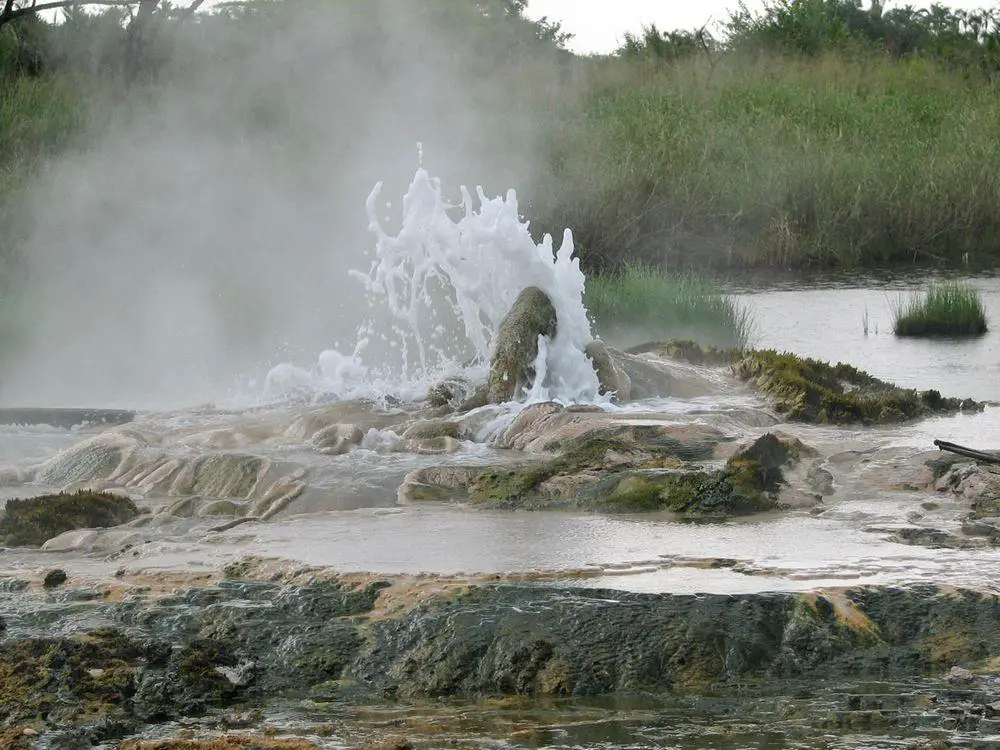Wondermondo 🢖 Lists and articles 🢖 Geysers of Africa
Publication
Geysers of Africa
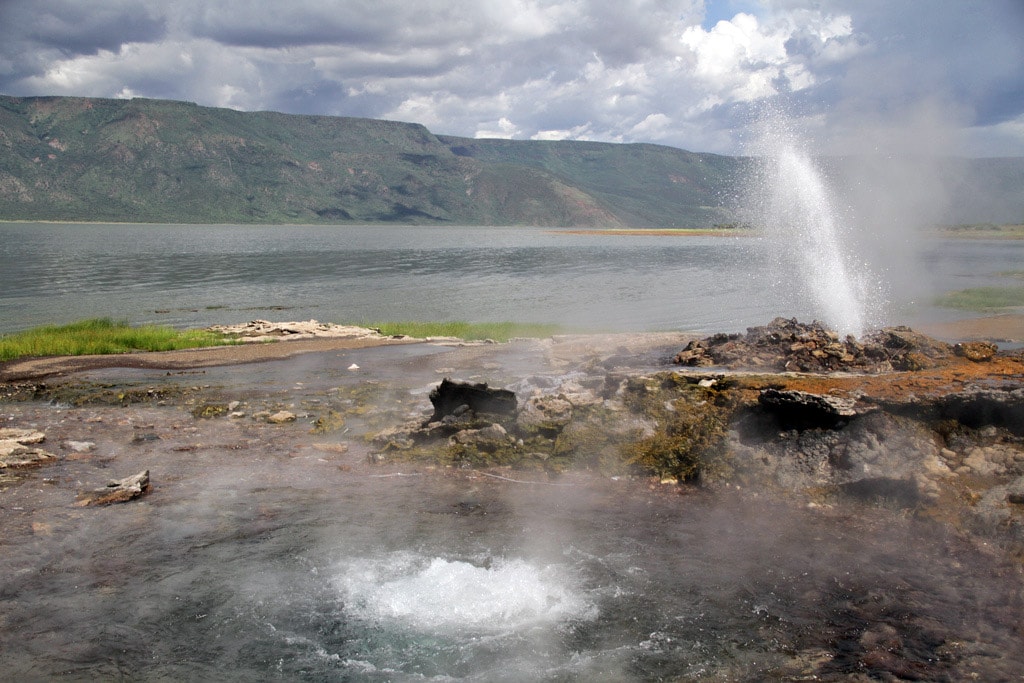
 In short
In short
Here are listed locations with geysers, extinct (or may be – dormant?) geysers, perpetual spouters and cold water geysers of Africa. Locations are listed in alphabetic order.
Map of the sites
If you see this after your page is loaded completely, leafletJS files are missing.
 List of the geysers of Africa
List of the geysers of Africa
01
Allalobed geysers and hot springs
 42.3%
42.3%
True geysers in Ethiopia, Afar
Surprisingly little known is the beautiful geothermal area south from Tendaho and Dubti.
This area is named "Allalobad" – "the waters of Allah", but often is named after the nearby villages.
One of the hot water pools here acts as a nearly constant geyser – Allallobeda Spouter, which often is 6 m tall but in rare cases – even 30 m tall. Surface of the water in this pool is 97°C hot.
There is one more geyser in another spring – it is just 0.3 m tall. Some more springs are pulsating, sometimes boiling more intensely.
02
Analavory Geysers
 40.8%
40.8%
Cold water geysers in Madagascar, Itasy Region
Analavory Geysers are not true geysers but partly artificial cold water geysers powered by carbon dioxide.
These springs have developed at the end of pipelines of abandoned mines and over the years have formed interesting travertine mounds.
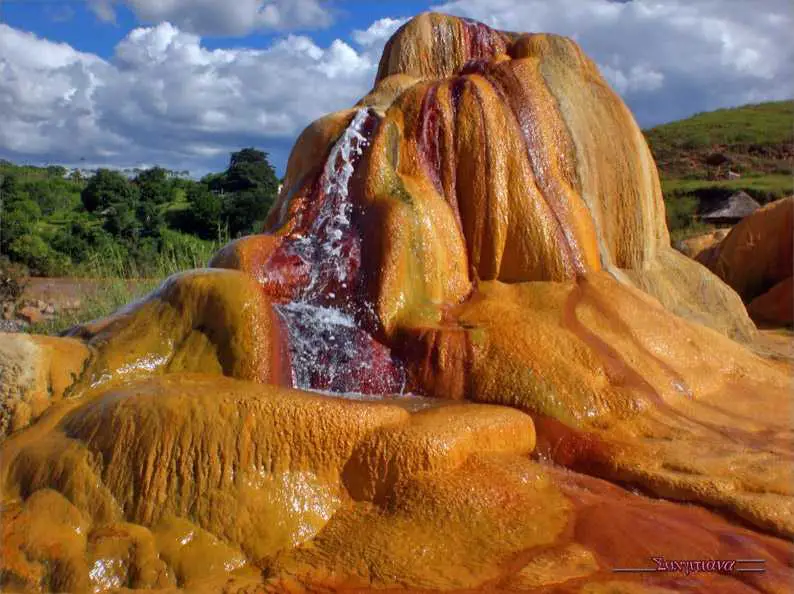
03
Buranga Hot Springs
 42.3%
42.3%
Perpetual spouter in Uganda, Western Region
Some of the most amazing hot springs in East Africa are Buranga Hot Springs. Currently, there are flowing 37 springs that receive the geothermal heat from the deep faults of the East African Rift System. One of the springs – Mumbuga spring – is a perpetual spouter – a permanent small fountain.
04
Chemurkeu Hot Springs, Lake Bogoria
 39.8%
39.8%
True geysers in Kenya, Rift Valley Province
Chemurkeu springs are located to the south of the most famous Lake Bogoria geysers – Loburu Geysers.
Springs are located close to the lake, some springs are even inside the lake. In total there are 40 hot springs, 4 geysers among them. One geyser is up to 1.2 m high, one is less than 0.3 m high. Geysers have formed carbonate terraces.
05
Dallol salt springs and geysers
 61.8%
61.8%
True geysers in Ethiopia, Afar
One of the most unusual places on Earth is Dallol Volcano. It is dubbed to be the most colorful place on Earth and the hottest place in the world. This is the only volcano in the world below sea level and without water over it. This place has got the only geysers of salt and acid in the world – and lots of them!
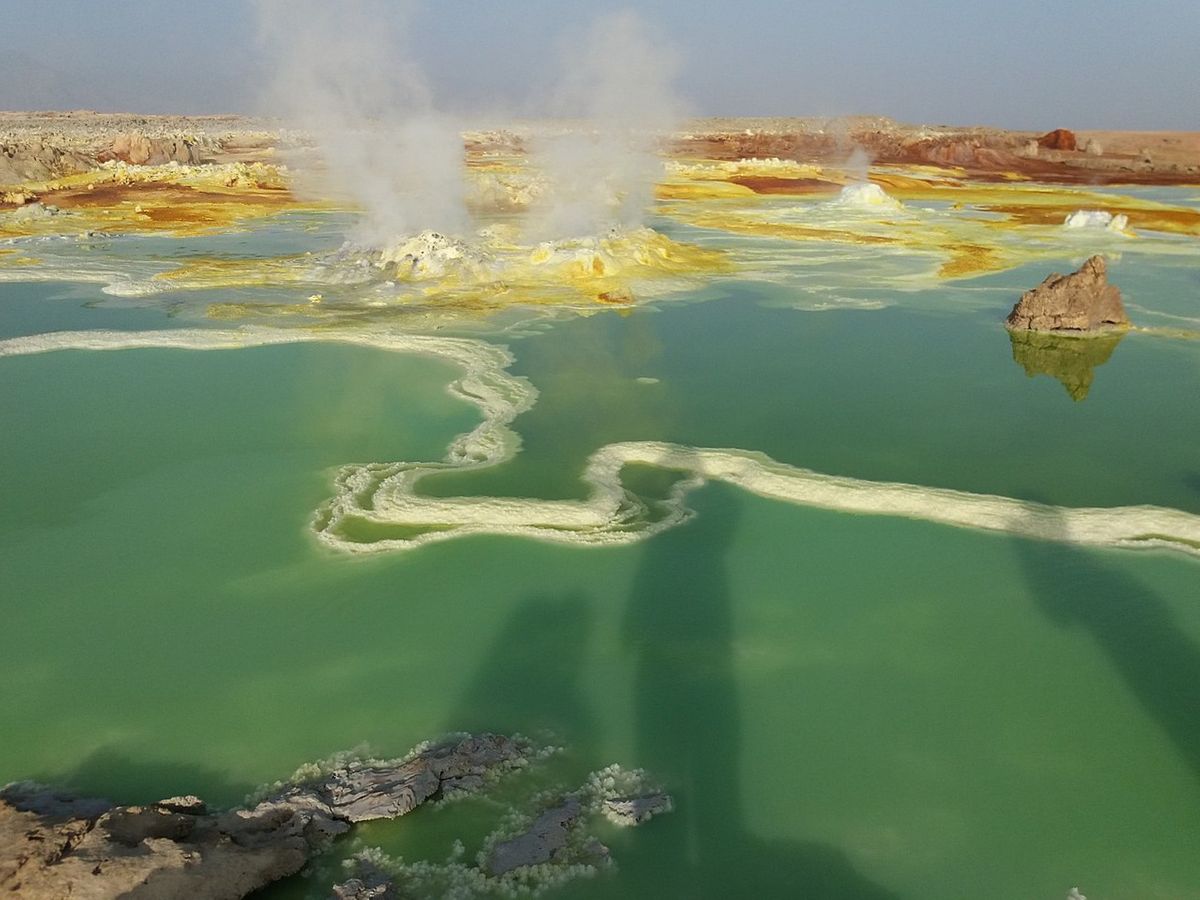
06
Lake Abaya Hot Springs (Chokore Hot Springs)
 37.8%
37.8%
Extinct geysers in Ethiopia, Southern Nations, Nationalities, and Peoples Region
There are numerous hot springs around Lake Abaya. Chokore Hot Springs (Chakoware Hot Springs) north of the lake recently had even some geysers.
Geysers were active there up to 1979 – the last geyser was erupting erratically, up to 1.8 m high.
07
Geyser of Edo Laki Island, Langano Lake
 28.5%
28.5%
Extinct geyser in Ethiopia, Oromiya
In the northern part of Langano Lake is a deep, round bay with an island in the center. This island has different names – Edo Laki, O’a, and also Geyser Island. For several decades here was located an impressive geyser, which now has disappeared.
08
 40.8%
40.8%
True geysers in Kenya, Rift Valley Province
A larger group of hot springs at Lake Bogoria. Here are located three geysers. The largest is Koibobei Geyser reaching up to 4.6 m high. Two more geysers are less impressive – 0.3 – 0.7 m high.
09
Loburu Geysers and Hot Springs, Lake Bogoria
 46.3%
46.3%
True geysers in Kenya, Rift Valley Province
The best place to see geysers in Africa is Lake Bogoria. In several locations around this lake at one time can be seen more than 10 geysers, but the best known here are Loburu Geysers.
Here are found more than 50 hot springs, at least 3 perpetual spouters, and six geysers, where one reaches up to 5 m high.
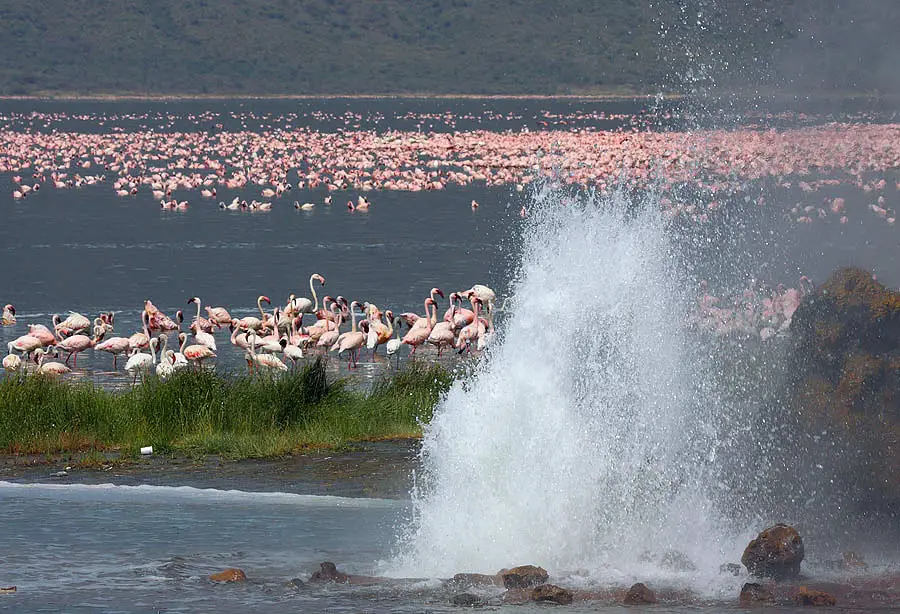
10
Logipi Geyser
 31.0%
31.0%
Extinct geyser in Kenya, Rift Valley Province
As the Suguta River is passing through the Gap (a place, where the flat Suguta valley is flanked by two volcanoes), the river is supplemented by numerous hot springs flowing from both sides of the valley. One of these springs – Logipi Geyser – up to recent times was an active geyser.
11
Losaramat Hot Springs and Geysers
 38.3%
38.3%
True geysers in Kenya, Rift Valley Province
Losaramat geothermal area is one of four areas with geysers around Lake Bogoria. Here are 17 hot springs with 3 geysers among them. Each of the geysers is some 0.7 m high.
12
North Island Geyser, Lake Turkana
 20.8%
20.8%
Extinct geyser in Kenya, Rift Valley Province
In 2004 there was observed geyser activity on the North Island of Lake Turkana. It is a deserted summit of a dormant volcano, crossed by a fault line. In the southern part of the island are observed hot springs and steam vents, fumaroles, and solfataras.
13
Soborom geothermal field and Yerike hot spring
 40.8%
40.8%
Extinct geyser in Chad, Tibesti
The most interesting geothermal features of Sahara are seen in Soborom geothermal field. Here are located steam jets, boiling mud pots, and solfataras.
The hottest spring pool is named Yerike – gas constantly is rising from it and the pool is bubbling as if boiling.
The temperature of springs in Soborom is between 22 and 88°C. Here is emanating also sulfur and iron, both have colored the soil in vivid colors.
14
Soro Hot Springs, Ol Kokwe Island
 33.3%
33.3%
Extinct geysers in Kenya, Rift Valley Province
The largest island in Lake Baringo is Ol Kokwe – the summit of an extinct volcano.
In 1902 here (above the lake level) existed springs which on a regular basis erupted – geysers. Over the last decades’ geysers have not been observed here anymore, here are located boiling springs.
 General description
General description
The best known geysers of the world are located in the United States, Iceland, and New Zealand, sometimes there are mentioned also geysers of Chile and Russia. But far less known are the other geysers of the world.
Wondermondo has made a summary of information about some of the least known geysers in the world – geysers of Africa.
True geysers exist in two African countries – Ethiopia and Kenya. In the past, they (possibly) existed in Chad. In Uganda is known interesting perpetual spouter, but in Madagascar – a beautiful cold-water geyser. There are unclear reports about geysers or cold water geysers in Zimbabwe and Zambia in the recent past.
Geysers of Ethiopia
Currently there are two active geyser fields in Ethiopia – Allalobed geysers and Dallol salt springs and geysers. Both are located in the Afar region. Dallol salt springs and geysers certainly belong to the most surprising geothermal features in the world – here exists a whole wonderworld of colorful salt terraces. Allalobed Geyser seems to be the most powerful in Africa – in rare cases, it has been erupting up to 30 m high.
In the past there were known more geysers along the East Africa Rift zone – but these are extinct now. It is still possible that there exist geysers not mentioned here.
Geysers of Kenya
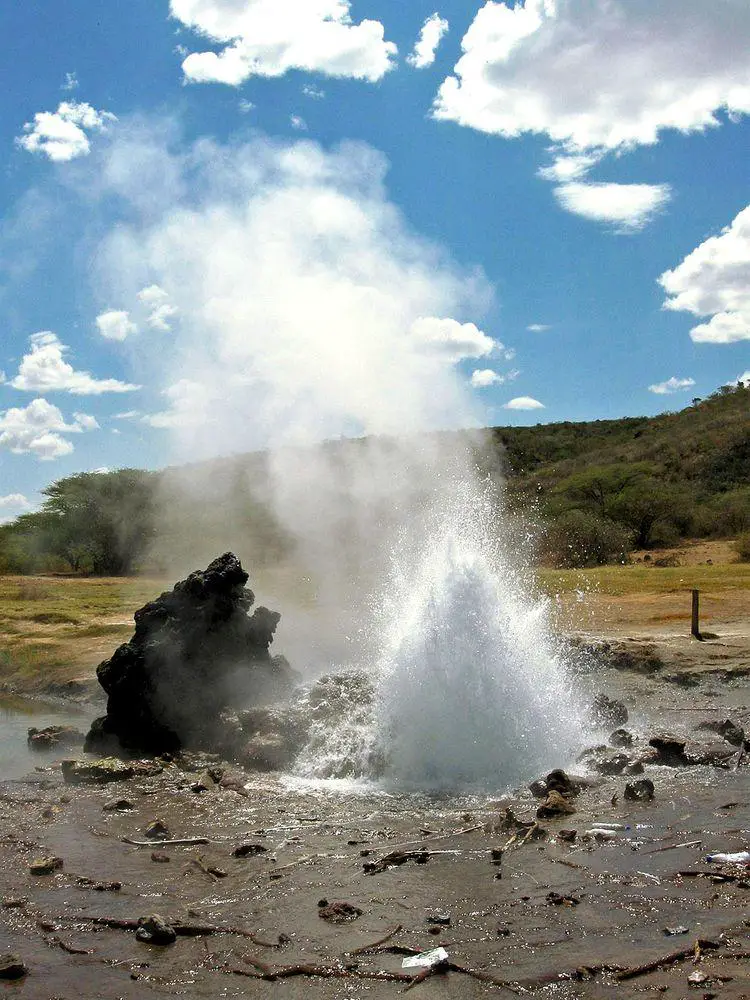
Kenya has the best geyser fields of Africa in four locations around Lake Bogoria. At one time there might be erupting 10 geysers, but several more are dormant and can start acting as the lake changes its water level.
In the past there were more geysers in Kenya – now they are extinct or dormant. It is well possible that there exist some more active geyser fields, not mentioned on this page.
Chad, Madagascar, Uganda
Reports about geyser in Tibesti Mountains, Chad are not convincing and nowadays here are up to 88°C hot, fervently boiling springs.
The interesting cold water geysers near Analovary (Madagascar) often are presented as true geysers. These springs have formed amazing travertine mounds and represent truly beautiful natural landmarks.
One of Buranga hot springs (Uganda) is perpetual spouter – "almost geyser". This amazing spring has formed a cone of travertine with a fountain on the top of it.
Are here listed all geysers of Africa?
In literature there have been mentioned some more geysers of Africa… which for the most part are not geysers:
- Chibwatata Geyser (10) in Matabeleland North, Zimbabwe most likely is a hot spring near Lake Kariba.
- Chilambwa Geyser (10) in the Southern Province of Zambia is considered to be an artesian well that decades ago was behaving like a fountain. Now here is a salt spring. If so – this is far from being a geyser.
- Chimanimani Geyser. (10) There have been reports about a geyser in Chimanimani, Manicaland Province, Zimbabwe. Water was spouting several feet high. Some of the springs (Nyanyadzi Hot Springs?, Rupise Hot Springs?) here are very hot, close to boiling, but there is not found any direct information about true contemporary geysers or perpetual spouters here.
- Goa Geysers near Shoma (11) – ?, Zambia. These seem to be cold-water geysers, as the temperature is shown 26 – 63°C. Mentioned that there are several spouting springs, which have created large deposits of tufa and sinter. Again – no more information…
- N’Kala Geysers(11) – Southern Province, Zambia. Mentioned as spouting springs in the work of D.Fergusson, 1903. Could not find any more information…
- Ta’hou geysers (4) – Afar (?), Ethiopia. These very well could be Allalobed geysers, but as well – some other geysers. Mentioned in the book of Charles Johnston, issued long ago – in 1844. The author writes, that his local guides told him about evil jinns embodied as "several boiling springs, a few yards distance from each other, that threw up columns of hot water and vapor, several feet high. Around the borders of these steam fountains, a large quantity of very white stone is found." The author mentions that this is in the country of Danakils, on the caravan route "from Owssa to Gondah" – placenames, which do not correspond to any known current place names in Ethiopia.
- Zongola Geyser (10, 11) (Fulunka Geyser) in Matabeleland North, Zimbabwe, (suspiciously close to Chibwatata Geyser – maybe it is the same?) is (or was) a hot spring with 90°C temperature. This spring might be flooded by Lake Kariba. Here were located 8 springs, one of them is (or was) perpetual spouter, up to 2.5 m high (local people in the 19th century told that earlier it was up to 5 m high), the temperature of the water – 97°C. Formed travertine and sinter.
Some other misunderstandings
In earlier literature there could be found a reference to spouting springs near Lake Hannington in Kenya (10). Well, many Eastern African lakes earlier were called in names given by Europeans, now we use local names. These are the same four groups of excellent geysers around Lage Bogoria, such as Loburu Geysers.
References
- Fergusson, David. The geysers or hot springs of the Zambesi and Kafue valleys. 1903.
- Glennon J. Alan, Pfaff M. Rhonda, The Operation and Geography of Carbon Dioxide-Driven, Cold Water "Geysers". 2004.
- Gouin, Pierre. Earthquake History of Ethiopia and the Horn of Africa. 1979, Ottawa.
- Johnston, Charles. Travels in Southern Abyssinia through the Country of Adal to the Kingdom of Shoa, 1844.
- Kalb, John. Adventures in the Bone Trade. The race to Discover Human Ancestors in Ethiopia’s Afar Depression. 2001.
- Nachtigal, Gustav. Sahara und Sudan, 1879, Leipzig, F.A.Brockhaus
- Nyakecho, Catherine. Preliminary Environmental Impact Assessment for the Development of Buranga Geothermal Prospect, Uganda. 2008. Accessed on June 15, 2011.
- Ochmann Norbert, Lindenfeld Michael, Barbirye Paula, Stadtler Christopher, Microearthquake Survey at the Buranga Geothermal Prospect, Western Uganda, Proceedings, Thirty-Second Workshop on Geothermal Reservoir Engineering. Accessed on June 15, 2011.
- Renaut, Robin W., R. Bernhart Owen, John K. Ego, Recent changes in geyser activity at Loburu, Lake Bogoria, Kenya Rift Valley. 2008.
- Scott, T. Bryan. The Geysers of Yellowstone, Fourth Edition. 2008, Boulder.
- Waring, A. Gerald. Thermal springs of the United States and other countries of the world. 1965.
Some interesting images
- Image of Allalobed geyser by Mark Haldane, Flickr.
- PhotoVolcanica.com, Dallol Volcano, TravelDope.net. Accessed on June 7, 2011.
 Recommended books
Recommended books
Geysers and Geothermal Energy
Geysers. What makes them work? Many who have seen a geyser in action know only that it spouts hot water into the air. Many others have never seen one. Chapter 1, Geysers of the World, delineates their distinguishing features, locates the geyser regions of the world, and places investigations by world travelers and scientists in a historic perspective.
Geysers: What they are and How They Work
In Geysers: What They Are and How They Work, T. Scott Bryan explains the geological setting that produces the pressure, heat, and abundant water necessary for a geyser to form and introduces readers to the variables that shape each geyser’s distinct personality. Some geysers spout just inches above a pool of water and others blast hundreds of feet in the air from conical vents.

